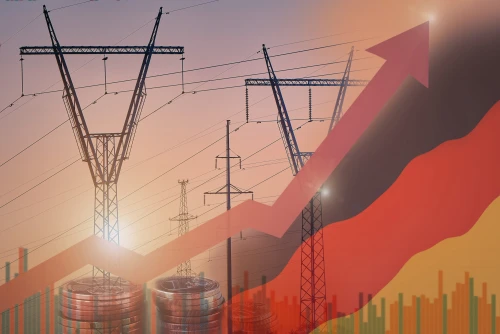
April 24th, 2025
Join our Italian Energy Day on 20 May – Book now
LCOE is a key metric for evaluating the financial viability of renewable energy projects, we explain how it is calculated.

The Levelised Cost of Electricity (LCOE) is a pivotal metric used to assess the financial viability of renewable energy projects, providing investors with a clear understanding of long-term cost projections. This standardized measure enables comparisons across different energy sources, helping stakeholders make informed decisions on renewable investments.
LCOE can be broadly calculated using two primary approaches.
The first approach considers the asset's overall value, including both construction and operational costs, balanced against the total energy produced over the plant’s lifetime.
The second approach sets the energy price relative to the total costs of the renewable energy plant. Here, plant owners determine the minimum price at which they can sell energy to cover the plant's lifetime expenses.
LCOE is also useful in projecting whether a new plant will be a financially viable investment.
The components factored into this calculation fall into the following categories:
Capital costs encompass the initial expenses required to establish a renewable energy plant. These often include real estate, construction, specialized equipment, setup fees, policy fees, applications, and regulatory costs. These upfront investments are typically the highest costs a renewable plant will face, largely due to the high price of technology and the lack of immediate income during the initial non-operational phase.
Operational expenses cover ongoing costs such as employee-related expenses like recruitment, salaries, training, and benefits. They also include routine costs, such as office supplies, employee amenities, and cleaning supplies for facilities and equipment. Task-specific expenses may involve building maintenance, equipment servicing, and costs associated with automation and control software.
In contrast to fossil fuel plants, renewable energy costs have low to no fuel costs by comparison. Fuel costs for renewable energy plants may include the initial fuel costs required to build the plant, depending on the type of plant, electricity or gas for heating or lighting of the building and automotive fuel for employees. If a renewable plant is able to, it makes financial sense to use energy generated on-site to power operational buildings, for example, using solar power from a solar plant to light office buildings. However, energy used is then not being sold, which incurs a loss to the plant, and other elements such as heating may require fossil fuels such as gas. Automotive fuel may be required for some vehicles and heavy vehicles, and electric vehicles may not be a suitable solution.
In addition to taking into account the set-up costs of a renewable plant, LCOE also examines the decommissioning cost of the plant once its lifecycle comes to an end. This could include the cost of demolition, clearing the site, disposal, and the cost of any regulatory guidelines that must be followed as part of a safe decommissioning.
Renewable energy has huge upfront costs: the technology required to build a plant and its accompanying network uses expensive materials and labour and requires stringent compliance considerations. We examine why LCOE is critical in assessing the cost competitiveness of renewable energy, with a focus on solar and wind power.
While certain methods of energy generation, including nuclear and coal, have stabilised or increased, the costs of renewable energy, including solar, have dropped considerably. Sunlight as an energy generator is also free, so renewable methods such as solar are now able to be competitive with fossil fuel plants because the cost of building plants has dropped comparatively to fossil fuel counterparts. Ongoing energy crises, such as geopolitical tensions, have also driven up the cost of fossil fuels, making renewable energy more desirable from a cost, political and environmental perspective.
Wind power is also getting cheaper due to developments, including larger turbine blades capable of generating more energy. This downward initial investment trend is expected to continue, so it's imperative that the comparative pricing potential of wind power is monitored. However, some updates to current LCOE models would be required to ensure their accuracy, which we will discuss in the LCOE limitations section of this article.
As well as plant owners or potential plant owners, governments and investors can also use LCOE to guide energy project decisions and policies. For example, the HM Government Department for Business uses LCOE metrics to help influence and advise on policy decisions relating to fossil-fuel-based energy generation versus renewable energy methods.
While LCOE is a valuable tool for estimating the lifetime cost of a renewable energy plant, it has certain limitations. It does not account for unexpected expenses or future shifts in the energy industry.
LCOE primarily considers present costs, technologies, and environmental conditions, which can evolve over time. This sensitivity to future price fluctuations in commodities and technology makes it less reliable for projects with long-term horizons.
Potential future tax policies favouring renewable energy are not included in current LCOE calculations. These may involve tax credits or lower tax rates for renewable energy companies, which could impact project costs significantly.
LCOE generally focuses on plant-level costs, often overlooking additional expenses related to energy distribution and broader network requirements. It also doesn’t factor in future grid adjustments that might be necessary as energy demands and infrastructure evolve.
While LCOE is instrumental in evaluating the potential of renewable energy projects, it has limitations in accounting for future uncertainties and additional investments. By understanding both its benefits and constraints, stakeholders can more effectively plan for a sustainable energy future.
Manage your market exposure with energy prices from around the world.

April 24th, 2025

April 23rd, 2025

April 22nd, 2025